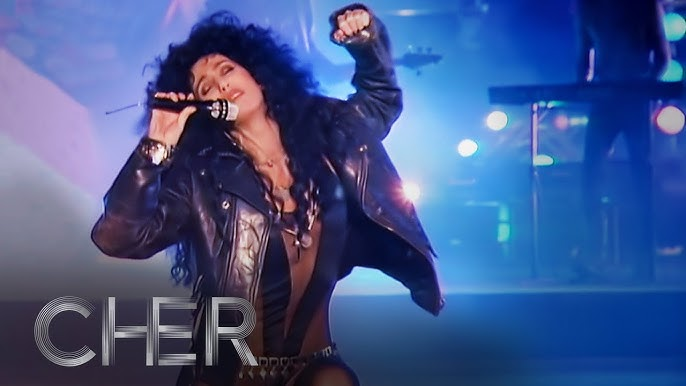By the late 1990s, Cher was already a household name—a cultural icon who had conquered music, television, and film. With a career spanning decades, from her folk-pop days with Sonny & Cher to her solo success in disco and rock, she had mastered the art of reinvention. Yet, in 1998, Cher did what no one expected: she redefined pop music with the release of her chart-topping single “Believe.”
This dance-pop anthem not only marked a major transformation in Cher’s sound but also pushed the boundaries of music production. “Believe” showcased her unmatched ability to adapt to changing musical trends while still staying true to her signature boldness and artistic vision.
The Making of “Believe”: A Groundbreaking Collaboration

To craft “Believe,” Cher collaborated with a talented team of producers and songwriters, including Mark Taylor and Brian Rawling. The track was born in the heart of the late ’90s dance music scene, blending upbeat tempos, catchy melodies, and innovative vocal effects.
Lyrically, “Believe” centered on themes of heartbreak, empowerment, and resilience—universally relatable ideas that struck a chord with listeners. Lines like “Do you believe in life after love?” captured the raw pain of moving on while delivering a powerful message of self-reliance and hope.
What truly set “Believe” apart, however, was its revolutionary use of Auto-Tune. While vocal correction tools were typically used subtly to fix pitch, producers deliberately applied Auto-Tune to Cher’s voice, creating a robotic yet emotive sound.
Auto-Tune: The Sound That Changed Music Forever
The bold use of Auto-Tune in “Believe” became its defining feature. At the time, the technology was relatively unknown and considered unconventional. Instead of hiding its effect, the producers amplified it, turning Cher’s vocals into a futuristic, almost ethereal instrument.
The result was nothing short of groundbreaking. The robotic vocal effect gave “Believe” an otherworldly quality that perfectly complemented its danceable beat and empowering lyrics. While initially polarizing, this creative risk introduced Auto-Tune as a legitimate artistic tool, paving the way for its widespread use in modern music.
Artists like T-Pain, Kanye West, and Lady Gaga would later embrace Auto-Tune as a creative signature, but Cher was the pioneer who dared to use it first. Her innovative approach to production cemented “Believe” as a turning point in pop music history.
Global Success: Breaking Records and Dominating Charts
Upon its release, “Believe” was an instant sensation, dominating charts worldwide. It topped the Billboard Hot 100 for four consecutive weeks, making it Cher’s first No. 1 single in the United States since “Dark Lady” in 1974. The song also achieved monumental success in the United Kingdom, where it became the best-selling single of 1998.
At age 52, Cher made history as the oldest female artist to top the Billboard Hot 100, shattering ageist perceptions in the music industry. Her triumph proved that talent, innovation, and authenticity could transcend generational boundaries.
The accolades poured in. “Believe” earned Cher a Grammy Award for Best Dance Recording, further solidifying its place as one of the most iconic songs of the decade. To date, the single has sold over 11 million copies worldwide, cementing its status as one of the best-selling singles of all time.
Cultural Impact: An Anthem of Resilience and Empowerment

What makes “Believe” timeless is its universal message of resilience. The song’s empowering lyrics resonate with anyone who has faced heartbreak, rejection, or life’s struggles. It’s more than just a dance track—it’s an anthem of hope and strength.
The infectious energy of “Believe” made it a staple in clubs, parties, and celebrations. But beyond the dance floors, it became a cultural phenomenon.
The song holds a special place in the LGBTQ+ community, where it is celebrated as a symbol of self-empowerment and pride. Cher’s bold persona, paired with the song’s uplifting message, solidified her as a beloved icon in the community.
The accompanying music video, featuring Cher in a sleek black outfit, vibrant hair, and futuristic visuals, added to its cultural significance. Her fearless fashion choices and magnetic stage presence inspired fans to embrace individuality and confidence.
The Legacy of “Believe”: Cher’s Lasting Influence

More than two decades after its release, “Believe” remains a cornerstone of pop music. Its influence can be felt across genres, as artists continue to experiment with Auto-Tune and vocal effects in creative ways.
Cher’s boldness in embracing new technology and her refusal to conform to expectations set a precedent for future musicians. She reminded the world that reinvention isn’t just possible—it’s essential for artistic growth.
For Cher, “Believe” was more than just another hit. It was a statement: that age, gender, or past achievements couldn’t limit her creativity. She proved that true artistry lies in taking risks, pushing boundaries, and staying true to one’s vision.
Conclusion: Why “Believe” Still Resonates Today

Cher’s “Believe” is far more than a pop song—it’s a cultural milestone that redefined the music industry. From its innovative use of Auto-Tune to its message of resilience and self-empowerment, the track continues to inspire listeners across generations.
It marked a bold reinvention for Cher, reaffirming her status as a trailblazing artist who could adapt to any era. Whether blasting through speakers at a club or providing solace after heartbreak, “Believe” remains as powerful and relevant today as it was in 1998.
Cher’s work on “Believe” serves as a timeless reminder that great music transcends boundaries, defies expectations, and leaves a lasting legacy. It’s no wonder the world still believes in life after love—and in the enduring magic of Cher.


